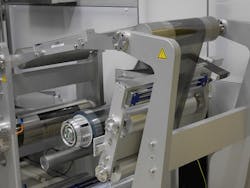Solliance achieves 12.6% efficiency for roll-to-roll perovskite PV cells
Solliance (Eindhoven, Netherlands), a partnership of R&D organizations from the Netherlands, Belgium, and Germany working in thin-film photovoltaic (TFPV) solar energy, has demonstrated an industrially applicable roll-to-roll (R2R) process for the production of perovskite solar cells that achieves a 12.6% conversion efficiency on the cell level.
RELATED ARTICLE: EPFL perovskite solar cells reach 21% efficiency
Perovskite microcrystals are a promising material to make high-yielding, thin-film solar cells. They can be processed into thin, lightweight, and potentially semitransparent modules that could eventually be integrated in building materials such as windows or curved construction elements. Solliance and its research partners focus on using scalable, industrial processes towards the fabrication of large-area modules, eventually suitable for seamless integration in a broad variety of PV systems.
The R2R process was developed for both the electron transport and the perovskite layers on the new Solliance dual R2R coating line, as developed by Solliance with its partners VDL Enabling Technologies Group (VDL ETG), Smit Thermal Solutions, and Bosch-Rexroth. The in-line R2R coating, drying, and annealing processes were executed at a linear speed of 5 m/min on a 30 cm wide commercial PET/ITO foil and under ambient conditions. After applying a newly developed off-line single device finishing step, individual solar cells of 0.1 square centimeter achieved efficiencies of up to 12.6%, measured under maximum power point tracking conditions during 5 minutes. All process steps on this R2R line were performed using low-cost materials while keeping the process temperatures below 120 degrees C, demonstrating the high-volume production potential of this new emerging thin-film PV technology.
VDL ETG has been leading the consortium of equipment manufacturing companies that designed and built the R2R coating line.
"The challenge is to upscale perovskite cells to larger size, industrially-manufacturable modules with high efficiency and long lifetime at low cost. These 12,6% R2R up-scaled perovskite-based solar cells are a first and important step in this development. With this result, we are confident to quickly boost the up-scaled perovskite based PV module efficiency above 15% by using low cost materials and processes. Furthermore, we are working hard to improve the stability of these devices under real life operational conditions," says Ronn Andriessen, program director at Solliance.
Thanks to its high power conversion efficiency and flexible and lightweight nature, thin-film perovskite PV technology is widely considered as a future key technology for the building-integrated photovoltaics (BIPV) market. It can be seamlessly integrated in building elements, on curved surfaces, and can be made semitransparent. Combining the industrially applicable manufacturing processes with Solliance’s proprietary back-end interconnection process allows the creation of perovskite-based PV modules with any form and shape and any desired current-voltage output. These properties will enable customized and aesthetic integration of solar modules for infrastructure, building, and vehicle-integrated PV products.
SOURCE: Solliance; http://solliance.eu/solliance-sets-world-record-for-roll-to-roll-produced-perovskite-based-solar-cells-with-a-stabilized-efficiency-of-126/

Gail Overton | Senior Editor (2004-2020)
Gail has more than 30 years of engineering, marketing, product management, and editorial experience in the photonics and optical communications industry. Before joining the staff at Laser Focus World in 2004, she held many product management and product marketing roles in the fiber-optics industry, most notably at Hughes (El Segundo, CA), GTE Labs (Waltham, MA), Corning (Corning, NY), Photon Kinetics (Beaverton, OR), and Newport Corporation (Irvine, CA). During her marketing career, Gail published articles in WDM Solutions and Sensors magazine and traveled internationally to conduct product and sales training. Gail received her BS degree in physics, with an emphasis in optics, from San Diego State University in San Diego, CA in May 1986.
